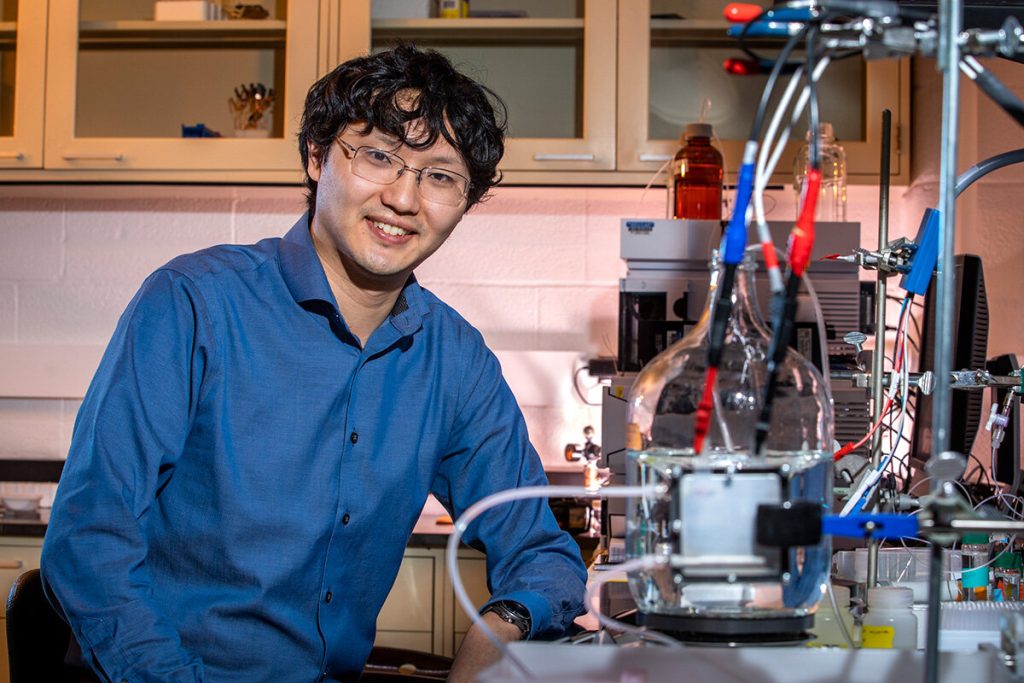Illinois chemical and biomolecular engineering professor Xiao Su and colleagues found a new approach for converting nitrate-contaminated waters—a known carcinogen and a cause of algal blooms in waterways—into valuable ammonia within a single electrochemical cell. Credit: Fred Zwicky
The nitrate runoff problem, a source of carcinogens and a cause of suffocating algal blooms in U.S. waterways, may not be all gloom and doom. A new study led by the University of Illinois Urbana-Champaign demonstrates an approach for the integrated capture and conversion of nitrate-contaminated waters into valuable ammonia within a single electrochemical cell.
The study, directed by chemical and biomolecular engineering professor Xiao Su, demonstrates a device capable of an eightfold concentration of nitrate, a 24-time enhancement of ammonium production rate and a greater than tenfold enhancement in energy efficiency compared with previous nitrate-to-ammonia electrocatalysis methods.
“By combining separation with reaction, we overcame previously existing limitations of producing ammonia directly from groundwater, where the concentrations of nitrate are very low, and thus make the conversion step inefficient,” Su said.
The findings are published in the journal Nature Communications.
“The goal of this study was to use as little energy as possible to remove nitrate from agricultural runoff before it hits our waterways, and transform it back to a fertilizer or sell it as a chemical feedstock,” Su said. “Our technology can thus have an impact on waste treatment, sustainable chemical production and advance decarbonization. We are hoping to bring greater circularity into the nitrogen cycle.”
The team developed a unique, bifunctional electrode that can separate and up-concentrate nitrate from a water stream, while converting to ammonia in a single unit using purely electrochemical control. “The bifunctional electrode combines a redox-polymer adsorbent, which captures the nitrate, with cobalt-based catalysts that drive the electrocatalytic conversion to ammonium,” Su said.
The system was tested in the lab using agricultural runoff collected from drain tiles around the U. of I. research farmlands to evaluate the potential of the technology for real-world conditions, the researchers said.
“This is a very efficient capture and conversion platform with a low footprint,” Su said. “We don’t need separate electrochemical cells for the water treatment and ammonium production or adding extra chemicals or solvents. Instead, we envision a module installed directly onto farmland and run using the power generated from the electrocatalytic process and a small solar panel.”
The team said its next goal is to develop even more selective materials used in the device to achieve higher nitrate removal and accelerate the conversion to ammonia—while engineering larger scale systems for practical deployment in the field.
Kwiyong Kim is the first author of the study, with contributions from Jaeyoung Hong and Jing Lian Ng, from the Su group. The work was carried out in collaboration with Tuan Anh Pham, from the Lawrence Livermore National Laboratory, and Alexandra Zagalskaya and Vitaly Alexandrov, from the University of Nebraska.
Su also is affiliated with the Beckman Institute for Advanced Science and Technology and also is a professor of civil and environmental engineering at Illinois.
More information: Kwiyong Kim et al, Coupling nitrate capture with ammonia production through bifunctional redox-electrodes, Nature Communications (2023). DOI: 10.1038/s41467-023-36318-1
Provided by University of Illinois at Urbana-Champaign
Citation: Study demonstrates energy-efficient conversion of nitrate pollutants into ammonia (2023, February 16) retrieved 20 February 2023 from https://phys.org/news/2023-02-energy-efficient-conversion-nitrate-pollutants-ammonia.html
This document is subject to copyright. Apart from any fair dealing for the purpose of private study or research, no part may be reproduced without the written permission. The content is provided for information purposes only.

